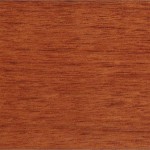What is Kempas Hardwood Flooring?
Botanical Name: Koompassia malaccenis.
Fast Facts
Color: Kempas heartwood is very light in color, usually white to light yellow. Kempas sapwood is more orange to red or reddish brown. Over time and with exposure to UV light, the floor will darken to a more reddish color.
Grain: The grain is interlocked and/or spiraled, and is generally rough.
Variations within Species and Grades: There is little variation within the species and grades.
Hardness/Janka: Kempas has a Janka Scale rating of 1,710, making it harder than most species used for hardwood flooring.
Dimensional Stability: This particular species of wood is not considered dimensionally stable, and is less stable than the traditional Northern Red Oak.
Sawing/Machining: Sawing and machining kempas is somewhat difficult because of hard deposits. It can dull and damage tools so it is important to be careful when working with kempas.
Sanding: Kempas is known to sand well.
Nailing: It may be difficult to nail because of how easily the wood may split.
Finishing: The coarse texture and acidic nature of the wood make finishing more difficult than some other species. It will need good filling to finish and polish well.
Availability: Limited availability.
A Brief Background on Kempas
Kempas is a hardwood with origins in Malaysia and Indonesia. It is naturally decay resistant and is acidic in nature. Typically used for hardwood flooring, cabinetry, furniture, and railroad ties, this hardwood is in high demand.
Durability
It is strong and can withstand a lot of wear and tear, but still should be cared for as any other hardwood floor. It is not a stable flooring choice, so those who choose to install it should expect movement. Avoid getting the floor wet as this will only contribute to more swelling and contracting.
Workability
Kempas is not an easy species of wood to work with because it is so hard and full of deposits. Tools should be regularly sharpened and sand paper should be changed regularly to keep it from getting clogged.
Where to Use
Kempas can be used in both residential and commercial settings where the color change will not interfere with the decor. It is durable enough to handle the high traffic of a commercial setting.
Care and Maintenance
When it comes to the proper care and maintenance of kempas flooring, use a finish that is best suited for the floor. The finish is what determines how to take care of a hardwood floor, so follow the instructions presented with your finish. Avoid water whenever possible, and keep dust, dirt and other debris off the floor as they could cause scratches in the finish. Use rugs and mats in high traffic areas.
Environmental Issues
Since the wood is not harvested in the United States, there are some issues with the legality of how the lumber gets here. While there are several reputable dealers and manufacturers who get the wood through the right channels, others do not take the proper measures to get kempas. Though not on the endangered list, sources are becoming sparse.


Wally Schmidt
I have just recently purchased some tongue and groove Kempas from an auction and I have been using it as a feature cieling on my back patio.As soon as the weather changed the characteristic of this wood changed.The patio is dry but the moisture in the air has distorted the flatness of the cieling to the point that I need to remove it all and use something less reactive to humidity change.Even some shelving which I had made for indoors has warped.I generally work with Jarrah,Marri and Blackbutt which I have no problem with.I would strongly recommend that any body intending to use kempas in West Australia look to another less reactive timber.